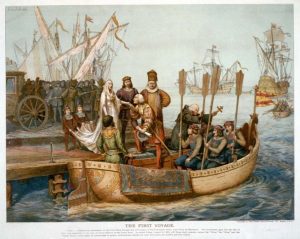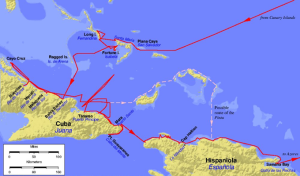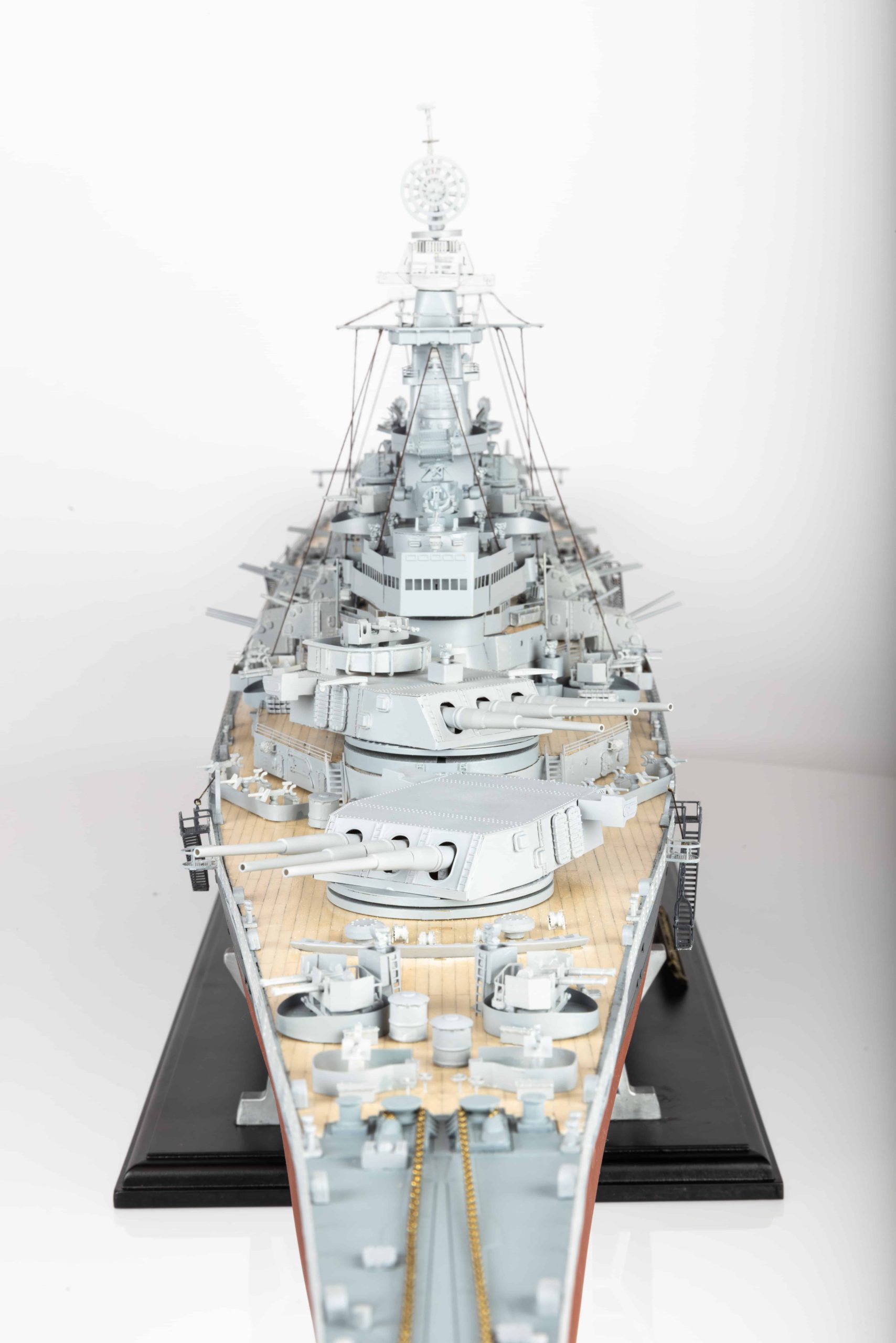La Niña, also known as ‘the little one,’ was famously the ship that housed Christopher Columbus’s cabin. In her early years, Niña was fitted with Latin sails; but then after that, she was equipped with square sails. Since Niña was such a small vessel, she was highly agile and manoeuvrable, but required a sturdy ballast to withstand the rough seas.
Columbus used Niña on his first voyage to the West Indies, in 1492. At the time, it was tradition for Spanish ships to bear female Saint’s names, and so she was called Santa Clara. However, the ship was commonly referred to as La Niña, which could have been an inside joke referring to the owner, Juan Niño.
Alongside La Niña throughout Columbus’ expedition were the Pinta, which was a caravel-type vessel much like La Niña, and the carrack-type Santa Maria. A carrack is typically an ocean-going ship with three or four sails.

- See Above: Christopher Columbus bidding farewell to Isabella I, the Queen of Spain, on his departure for the New World, August 3, 1492.
As previously mentioned, Niña was fitted with Latin sails at first, but was later re-rigged with square sails for optimised performance in the ocean. Whilst there isn’t much, if any accurate documentation of Niña’s design, the ship is thought to have weighed around 60 tonnes, with a 15-metre deck. There are conflicting accounts regarding the number of sails Niña had, with some claiming there to have been three, and others four.
On Christopher Columbus’ first voyage, La Niña carried a crew of 26 men, and she was captained by Vincente Yanez Pinzon, a famed Spanish navigator. He departed from Palos de la Frontera with his three ships, and he was actually aboard the Santa Maria, the largest of the three.
It was on the 7th October 1492 that the crew spotted a flock of birds, signifying their proximity to land, and a few days later the captain of the Pinta, Martin Alonso Pinzon, confirmed the land sighting and signalled Columbus. Columbus would go on to state he had already spotted the land, and so he’d be given the lifetime pension promised to whomever first saw land by King Ferdinand and Queen Isabella.
Christopher Columbus named this island San Salvador, and it’s now known as the Bahamas. He called the inhabitants Indians, and was curious in regard to their golden ear ornaments. He later imprisoned the locals, and forced them to guide him to the source of the gold. Columbus also noted how primitive they were in terms of warfare, and is believed to have said, “The people here are simple in war-like matters… I could conquer the whole of them with fifty men, and govern them as I pleased.”
After this, Columbus ventured to the northern coast of Cuba in late October, before journeying to Hispaniola in December. The Santa Maria ran aground on Christmas Day of that year, and there was no other choice but to abandon her. Columbus decided to use the wreckage as a source for target practice for their cannons, to impress the local people. A native chieftain, Guacanagari, accepted Columbus and granted him permission to leave some of his men behind. Christopher Columbus then founded the settlement of La Navidad, in present-day Haiti.
His last stop of the voyage was in the Bay of Rincon, in northeast Hispaniola. This was in January of 1493, and here he encountered the Ciguayos; the only group of natives who were violently resistant towards Columbus and his men.
Columbus then set sail for Spain, and La Niña was almost capsized in February 1493, in the east of the Azores. This is a small archipelago in the North Atlantic, around 900 miles west of Portugal’s capital, Lisbon. A storm was tossing the ship across the waves, and Columbus subsequently ordered his crew to take a series of vows to perform specific acts when they returned to Spain, such as religious pilgrimages. A month later, on the 4th March 1493, La Niña reached Lisbon.

- See Above: A map highlighting the route of Christopher Columbus’ first expedition.
Six months after this, La Niña found herself joining a fleet of seventeen ships for the second journey to Hispaniola, in the Caribbean. She became the flagship for the exploration of Cuba, the biggest island of them all, and was subsequently the only ship to withstand the 1495 hurricane. She later returned to Spain in 1496.
Niña’s next journey was an unauthorised voyage to Italy’s capital, Rome. The ship was captured by pirates when disembarking from Cagliari, and was then taken to Sardinia. Niña’s captain at the time, Alonso Medel, managed to escape from the pirates with a few of his men. He stole a small boat, rowed back to La Niña, and he and the remaining crew then sailed to Cadiz.
La Niña returned to Hispaniola in 1498, serving as an advance guard of Christopher Columbus’ third voyage. In 1500, she set sail from Santo Domingo, Dominican Republic, and then in 1501, she made a trading voyage to the Pearl Coast on the island of Cubagua, in Venezuela. After this, there’s no log of La Niña’s travel, but it’s thought she registered approximately 25,000 nautical miles under the command of Christopher Columbus.
Premier Ship Models offer a selection of fantastic model ship replicas of La Niña. They’re all terrific recreations of the real-life counterpart, and serve as wonderful conversation pieces for enthusiasts of historical ships, expeditions and Christopher Columbus alike.
- Jack Ratledge
Customer Reviews
 vincent bekaert2024-09-13After a Dutch company told me they were no longer taking orders, a Chinese company did not respond and an American one did not offer the desired finish, I ended up at Premier Ship Models in January 2024. I opted for a premium finish from 6-8 months for the build of a 1990 Hinkley Sou'wester. With nothing more than a top view and a side view and a lot of photos they got to work. 9 times I got an update with photos to assess the progress and make comments. I happily made a photo album of this. I asked for quite a few corrections, which were all carried out. The only downside was a huge underestimation of the shipping costs. But the ship was very well packed and delivered in September. The sailing ship had suffered a bit on the journey, but I was able to repair that easily, except for the downhaul - it was too simple and would break off again immediately. I left that out (it would still be nice to receive a "real life" version). The correspondence was very good, my sincere thanks to the team for the great job!
vincent bekaert2024-09-13After a Dutch company told me they were no longer taking orders, a Chinese company did not respond and an American one did not offer the desired finish, I ended up at Premier Ship Models in January 2024. I opted for a premium finish from 6-8 months for the build of a 1990 Hinkley Sou'wester. With nothing more than a top view and a side view and a lot of photos they got to work. 9 times I got an update with photos to assess the progress and make comments. I happily made a photo album of this. I asked for quite a few corrections, which were all carried out. The only downside was a huge underestimation of the shipping costs. But the ship was very well packed and delivered in September. The sailing ship had suffered a bit on the journey, but I was able to repair that easily, except for the downhaul - it was too simple and would break off again immediately. I left that out (it would still be nice to receive a "real life" version). The correspondence was very good, my sincere thanks to the team for the great job! Douglas Holmes2024-09-10The first time I used Premier Ship Models was for a kit of the Batavia, this year. (2024). I was so happy with the service that when I was looking at getting the 'ghost ship' The Flying Dutchman, I checked around online and was extremely pleased to find they had it. Not only that but they were cheaper than other model ship kit suppliers I have used in the past. And again, on top of that it only took 8 days to get from placing the order in the UK to having FedEx deliver it on my doorstep in Western Australia. To put that into perspective, I am still awaiting delivery via Australia Post for some parts from Sydney NSW, three separate orders placed 15 days ago.... Extremely satisfied and would recommend them to anyone.
Douglas Holmes2024-09-10The first time I used Premier Ship Models was for a kit of the Batavia, this year. (2024). I was so happy with the service that when I was looking at getting the 'ghost ship' The Flying Dutchman, I checked around online and was extremely pleased to find they had it. Not only that but they were cheaper than other model ship kit suppliers I have used in the past. And again, on top of that it only took 8 days to get from placing the order in the UK to having FedEx deliver it on my doorstep in Western Australia. To put that into perspective, I am still awaiting delivery via Australia Post for some parts from Sydney NSW, three separate orders placed 15 days ago.... Extremely satisfied and would recommend them to anyone. cashrc2024-08-13Premier Ship Models did a great job of finding the kit I was after, an Aeronaut Pilot boat. Once found, it shipped quickly, but was held up in customs. Premier reached out to me and customs, and I received the kit a few days later. Premier is now one of my go-tos for European and Asian rc ship models.
cashrc2024-08-13Premier Ship Models did a great job of finding the kit I was after, an Aeronaut Pilot boat. Once found, it shipped quickly, but was held up in customs. Premier reached out to me and customs, and I received the kit a few days later. Premier is now one of my go-tos for European and Asian rc ship models. Bob moore2024-08-12fast and friendly service. thank you.
Bob moore2024-08-12fast and friendly service. thank you. Tim Fletcher2024-08-12Best place for your model needs without a doubt. I had a little trouble with an order (not Premier's fault) and I couldn't have asked for better support. Whenever I needed an answer or had a question the people at Premier responded usually within 24 hrs. They never left me waiting for an answer. Best business I have seen for customer service.
Tim Fletcher2024-08-12Best place for your model needs without a doubt. I had a little trouble with an order (not Premier's fault) and I couldn't have asked for better support. Whenever I needed an answer or had a question the people at Premier responded usually within 24 hrs. They never left me waiting for an answer. Best business I have seen for customer service. William Madar2024-08-12Excellent selection.
William Madar2024-08-12Excellent selection.
Information


My account
Legal


Follow Us
Follow us to keep up-to-date using our social networks

Copyright © 2024. Premier Ship Models. All Rights Reserved.

